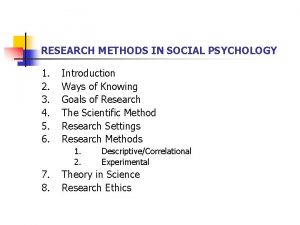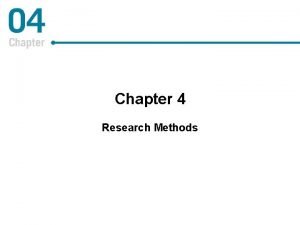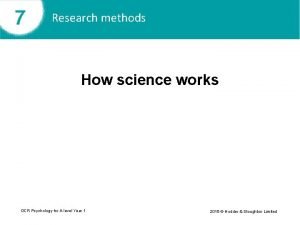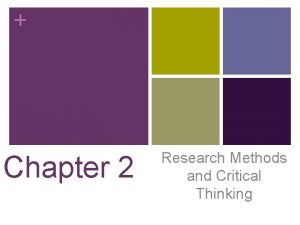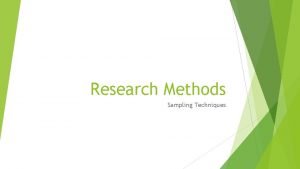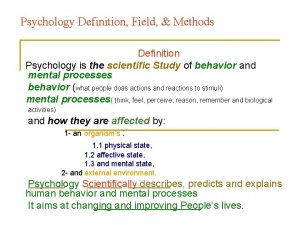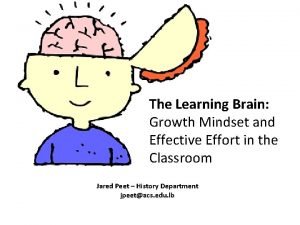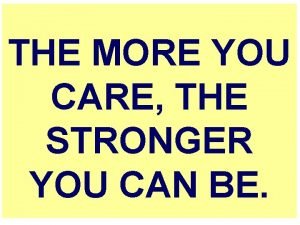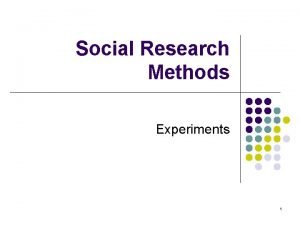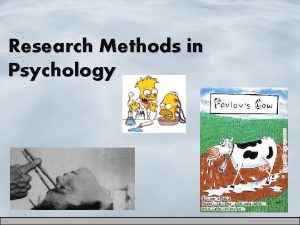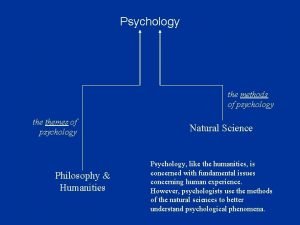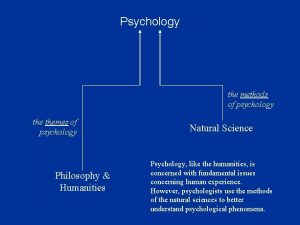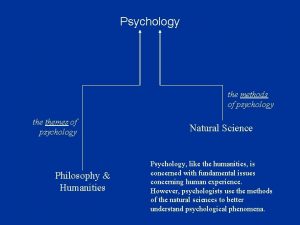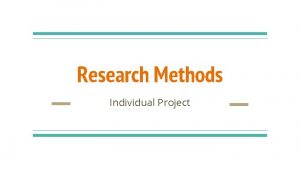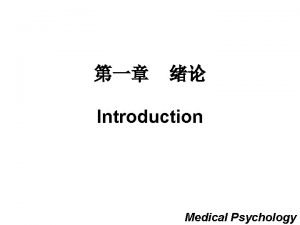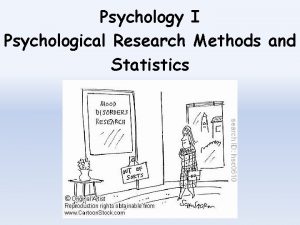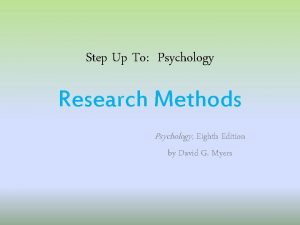Research Methods in Psychology Experiments Can You Follow































- Slides: 31

Research Methods in Psychology Experiments

Can You Follow Directions? • Complete the worksheet “Can you follow directions? ” • When you are finished, please sit quietly

How does this connect? • Experiments are the epitome of psychological research. They are the most important research method to the field of psychology. • It will help you understand experiments in science and help you discover new things about human behavior.

Following Directions • What did we learn about human behavior? • We want to be considered the best! • Being told to follow directions causes you to immediately follow them, no matter what. This might be especially true for a school setting.

Results/Data Followed Directions Did not follow directions

Discussion • What might cause someone to follow directions incorrectly? • Does it make sense to follow every direction blindly?

Experimentation • How did I operationally define my variables? YELLING NAME, FOLLOWING UNNECESSARY DIRECTIONS ABILITY TO FOLLOW DIRECTIONS SITTING QUIETLY

Operational Definitions Describing a variable using specific, measurable traits. How does listening to Beyoncé songs affect mood? – Listening to Beyoncé songs: ALL THE SINGLE LADIES 1 time through with headphones in a room by yourself. – Mood: RATING OF HAPPINESS ON A 10 POINT SCALE • How does reading affect intelligence? – –

• Experiment: a research method used to determine cause and effect between variables

• Independent Variable: the variable you manipulate IV TRICKY DIRECTIONS • If the directions were read carefully, only steps #1 and #2 would have been followed.

• Dependent Variable: the outcome of the independent variable (what is being measured in the study? ) DV ABILITY TO FOLLOW DIRECTIONS How many of you followed directions perfectly?

• Confounding Variables – One or more variables not under the control of the experimenter that can change the outcome of the results. EX: If some of you were not able to read the directions, or simply did not care to do the bellringer.

Research Settings • Laboratory Experiment – a setting designed for research – provides uniform conditions for all subjects – Eliminiates confounding variables – may seem artificial

Research Settings • Field research – behavior observed in real-world setting – measures may be more representative of reality – poor control over conditions Collect the data: Field Experimentation: Gender Conformity

Data-Collection Methods • Self-report procedures in which people rate or describe their own behavior or mental state – questionnaires – rating scales • on a scale from 1 to 7 rate your opinion of … – judgements about perceptions • on a scale from 1 to 100 how hot is. . .

Data-Collection Methods • Observational methods in which researchers directly observe and record behavior rather than relying on subject descriptions – naturalistic observation - researcher records behavior as it occurs naturally – tests - researcher presents stimuli or problems and records responses

Examples • Writing with colored pencils effects academic performance in high school • Eating breakfast improves performance on FCAT • People with unusual names are less successful

Variables Independent Variables CAUSE Dependent Variables EFFECT CAUSE

Dependent Variable IV=Light Low Light Growth Normal Light DV=Growth More light CAUSES increased GROWTH in plants

Mother’s Milk vs. Cows Milk • Correlational research has found a positive correlation between mother’s milk and intelligence – But does this mean that smarter mothers (who more often breast feed) have smarter babies? – Or does it mean that nutrients in mother’s milk contribute to brain development?

Experimentation • Mother’s milk CAUSES babies to be smarter at age 8 – HOW DO YOU THINK THE RESEARCHERS OPERATIONALLY DEFINE SMARTER? ? Mother’s Milk IQ Cow’s Milk ?

How does doing yoga cause you to lose weight?

THINK • If I have some people do YOGA and some people GO ON A DIET, will I be able to determine that YOGA CAUSED people to lose weight? – What if both groups gain 5 lbs because of aging? YOGA WIEGHT DIET

THINK • I can tell yoga CAUSES people to lose weight by comparing the people that do yoga to people that don’t. YOGA WIEGHT NO YOGA

Experimental and Control Group • Experimental Group: group you DO SOMETHING to • Control Group: group you DON’T do something to – This helps us determine cause and effect Experimental Yoga Weight No Yoga Control

Practice • Do sex education programs reduce teen pregnancies? – INDEPENDENT/DEPENDENT VARIABLE? – EXPERIMENTAL/CONTROL? – CONFOUNDING VARIABLES? Sex Education Teen Pregnancy No Sex Education

Practice • How does smoking marijuana effect your memory? – INDEPENDENT/DEPENDENT VARIABLE? – EXPERIMENTAL/CONTROL? – CONFOUNDING VARIABLES? Smoking No Smoking MEMORY

Independent Practice – draw the three boxes in your notes • Does beating a dog make it aggressive? IV? DV? Experimental Group? Control Group? Confounding variables?

Independent Practice – draw the three boxes in your notes • Does eating hot Cheetos make you burp more during the day? IV? DV? Experimental Group? Control Group? Confounding variables?

Exit Ticket DRAW THE BOXES. LABEL VARIABLES AND GROUPS. If there is a potential confounding variable, label it. • Does eating breakfast improve performance on ACT testing? • Are people with unusual names are less successful? • Does drinking alcohol reduce reaction time?

Exit Ticket • Create a table that displays the strengths and weaknesses of field and laboratory experiments.
 I will follow you follow you wherever
I will follow you follow you wherever Selecting a topic and purpose
Selecting a topic and purpose If you think you can you can poem
If you think you can you can poem Abnormal psychology experiments
Abnormal psychology experiments Why is “replication key” psychology experiments?
Why is “replication key” psychology experiments? Methods of social psychology
Methods of social psychology Research methods in developmental psychology
Research methods in developmental psychology Research methods in abnormal psychology
Research methods in abnormal psychology Ocr psychology research methods
Ocr psychology research methods Critical thinking chapter 2 answers
Critical thinking chapter 2 answers If you can imagine it you can achieve it
If you can imagine it you can achieve it Quotes about measurement
Quotes about measurement If you can't measure it you can't manage it
If you can't measure it you can't manage it Can't manage what you don't measure
Can't manage what you don't measure Vertikale bilanzkennzahlen
Vertikale bilanzkennzahlen Fabrication of wax pattern
Fabrication of wax pattern You can tell harris about it just ____(easily) as i can.
You can tell harris about it just ____(easily) as i can. You can tell harris about it just ____(easily) as i can.
You can tell harris about it just ____(easily) as i can. How to be more impressive 1+1=2
How to be more impressive 1+1=2 I know nothing is impossible
I know nothing is impossible Wherever you lead me i will follow
Wherever you lead me i will follow Act iv merchant of venice
Act iv merchant of venice How to make quiet follow you
How to make quiet follow you Sampling methods psychology
Sampling methods psychology Psychology definition
Psychology definition Industrial psychology jobs
Industrial psychology jobs Descriptive methods psychology
Descriptive methods psychology Pure psychology
Pure psychology You can't turn right here. you turn left
You can't turn right here. you turn left Have a daughter so you can argue
Have a daughter so you can argue Jared peet
Jared peet The more you care the stronger you can be
The more you care the stronger you can be





